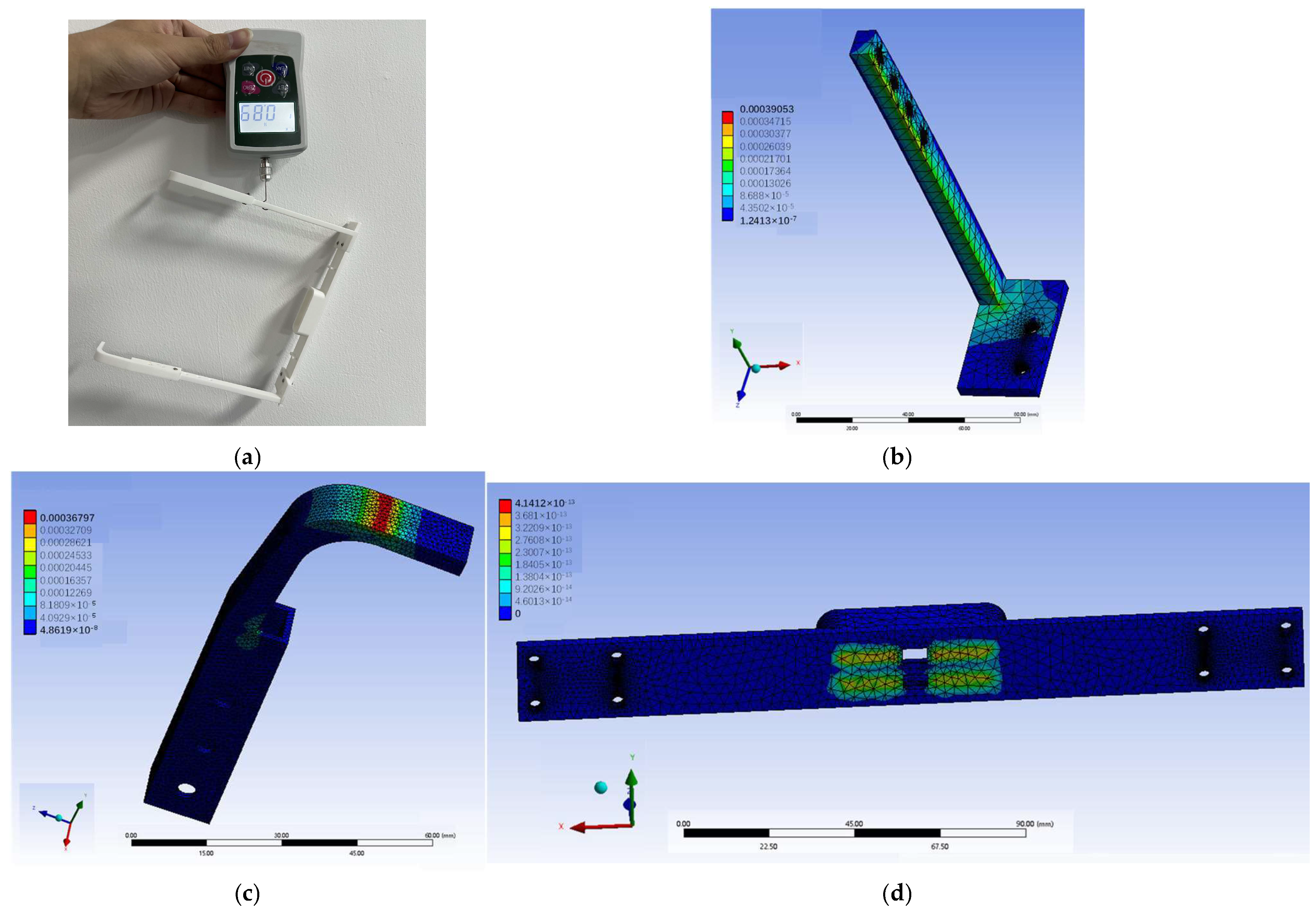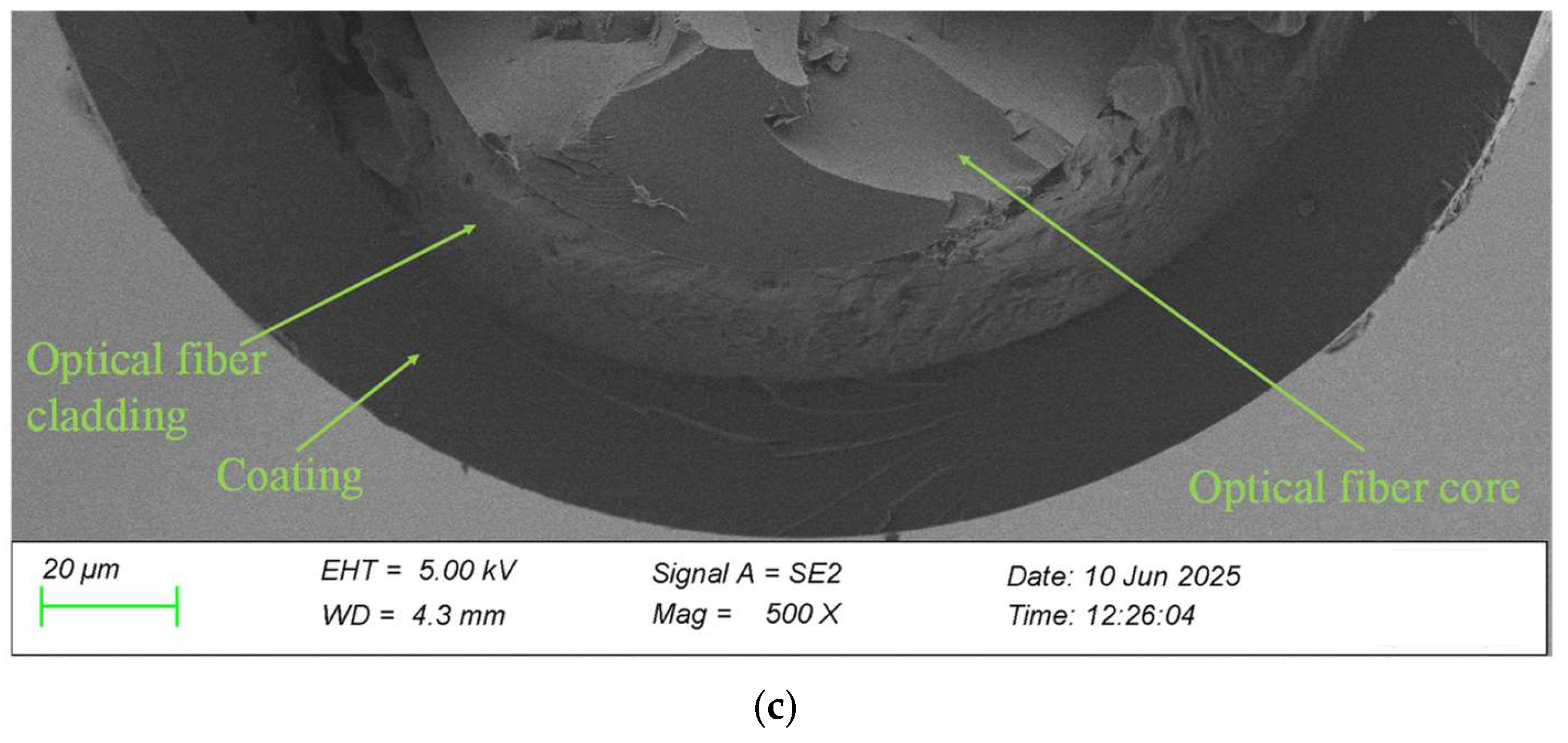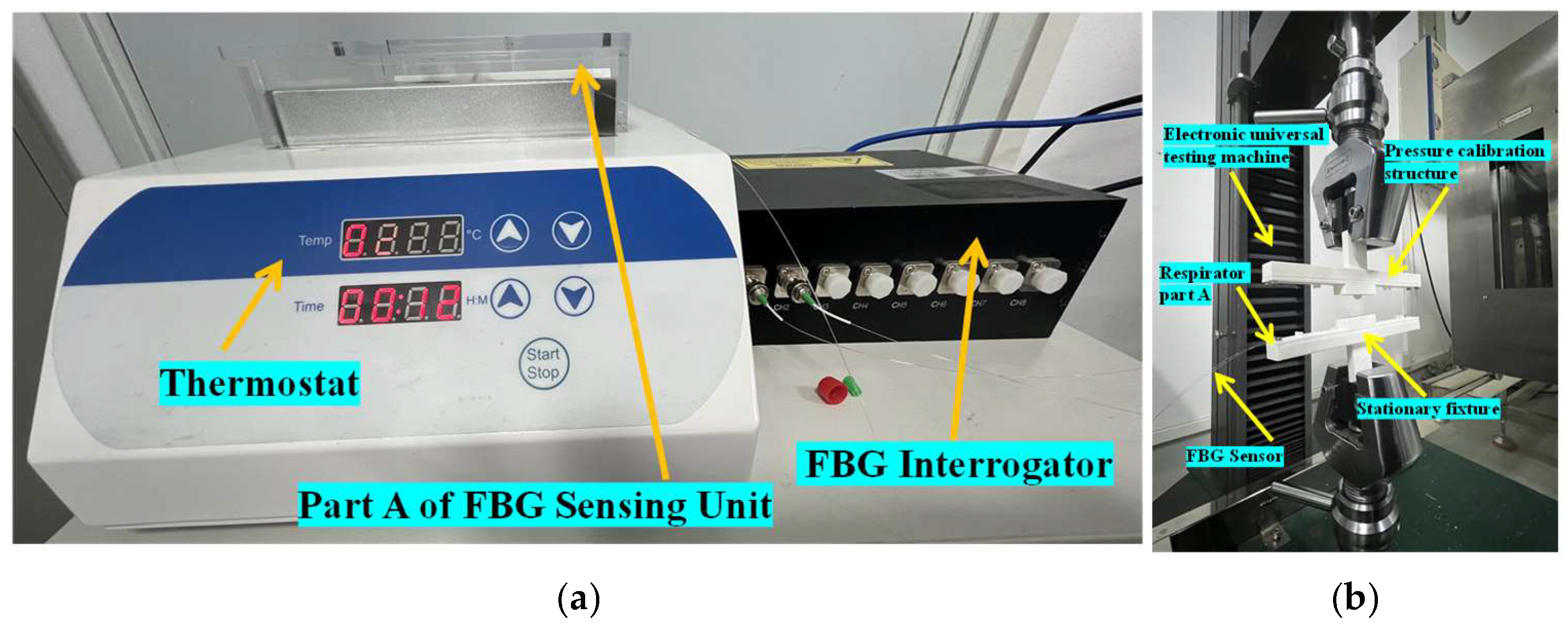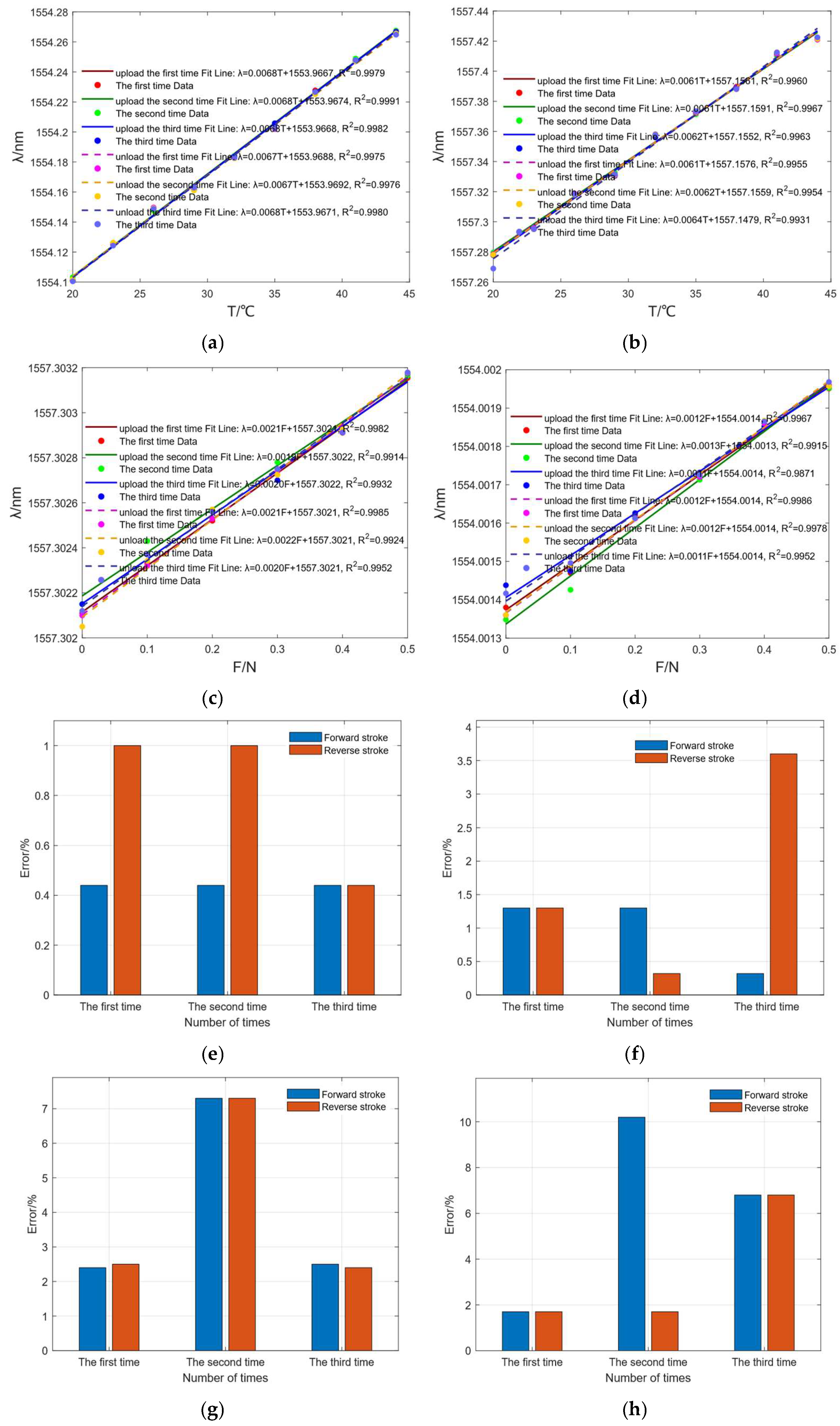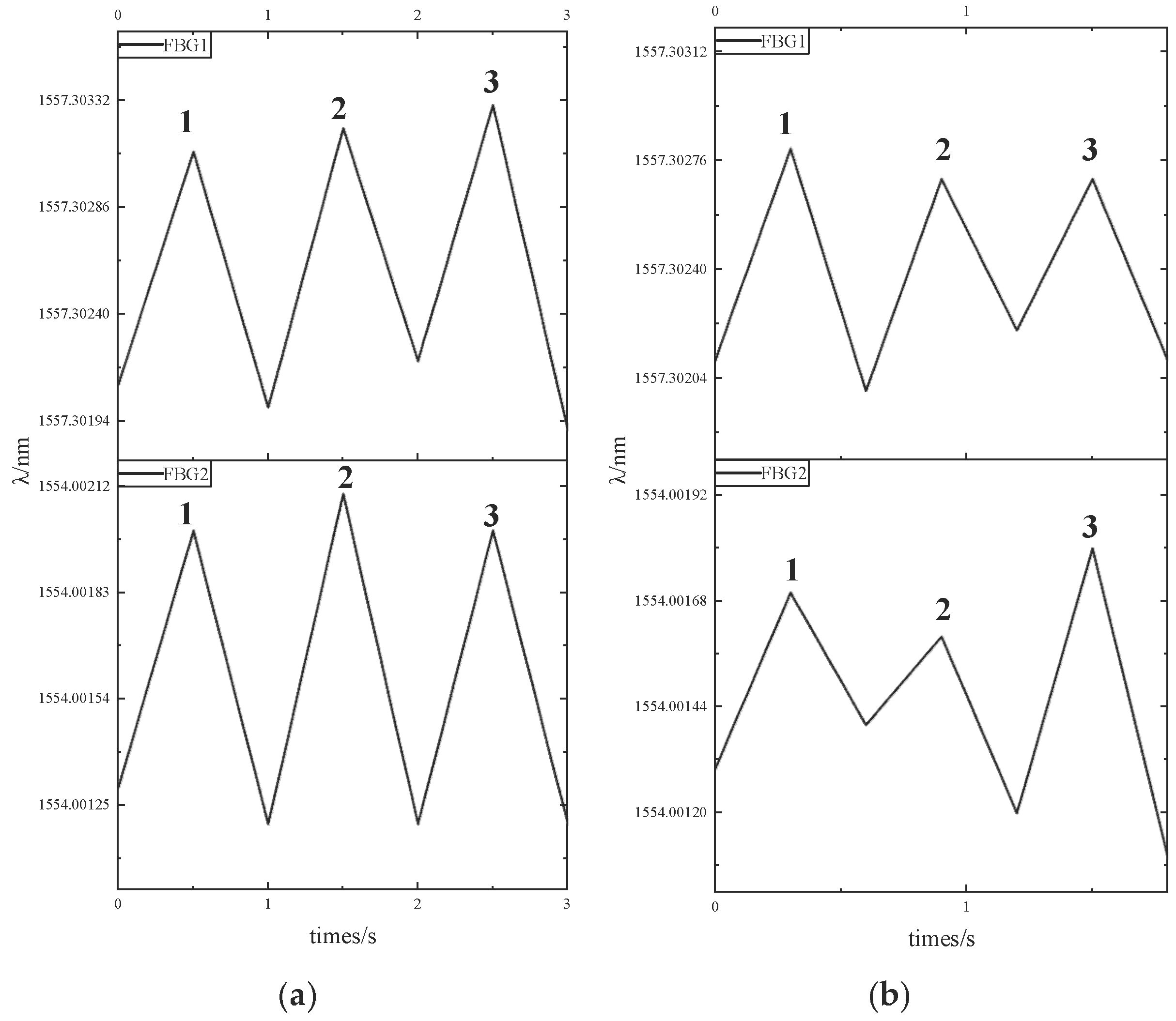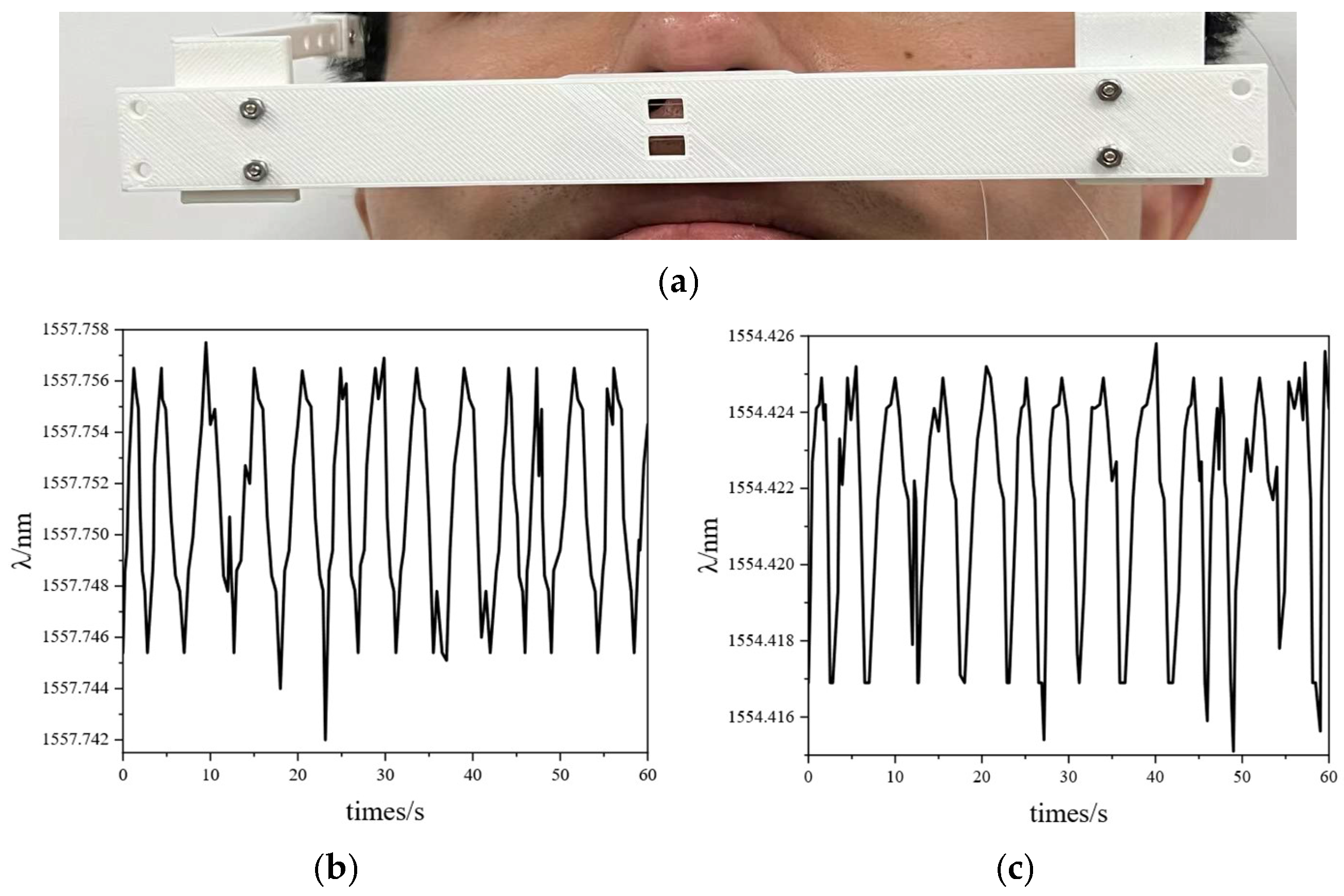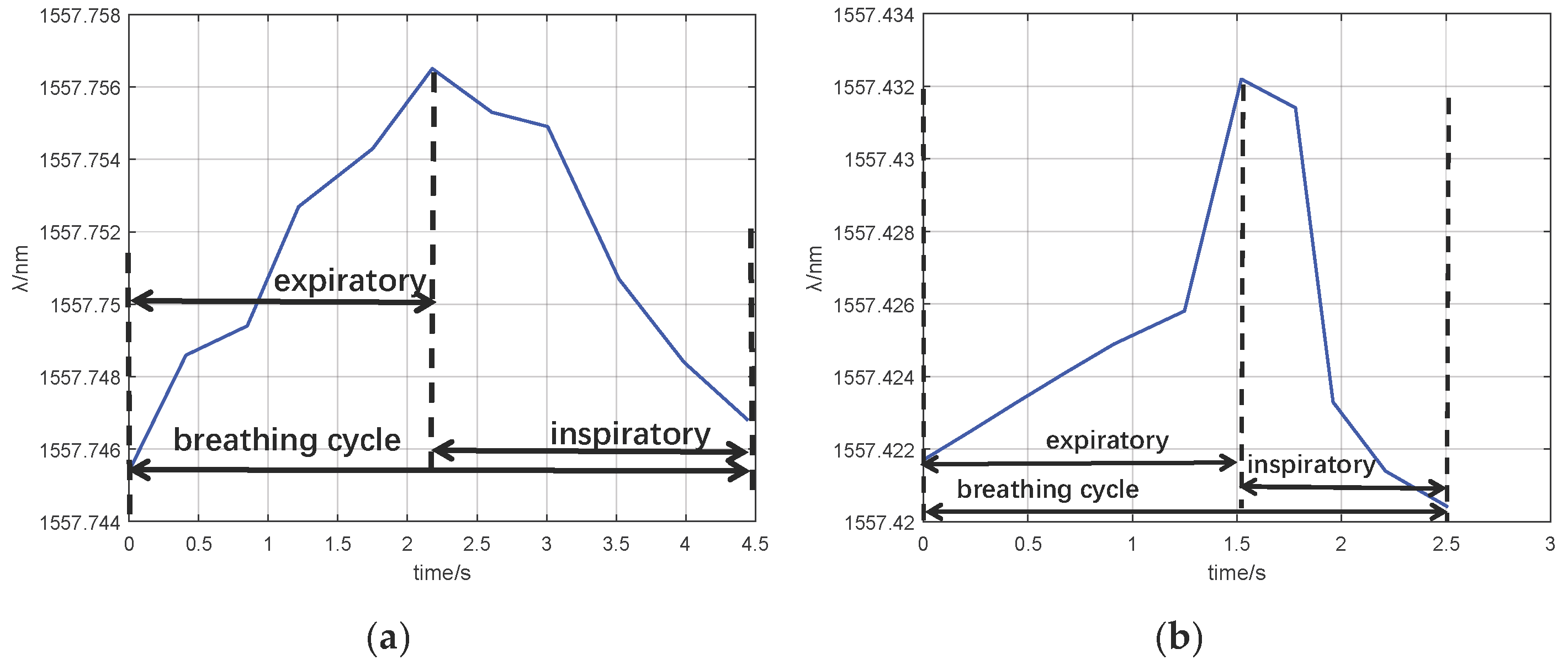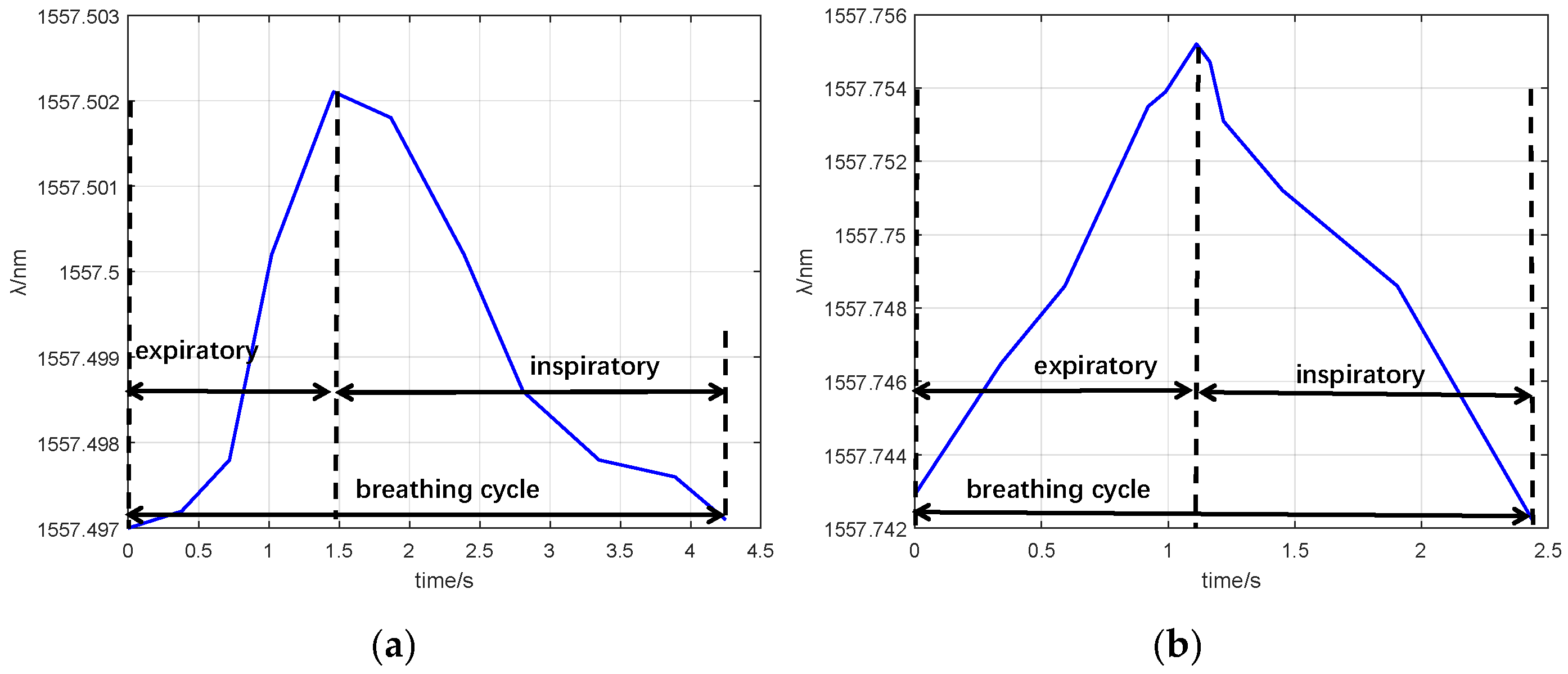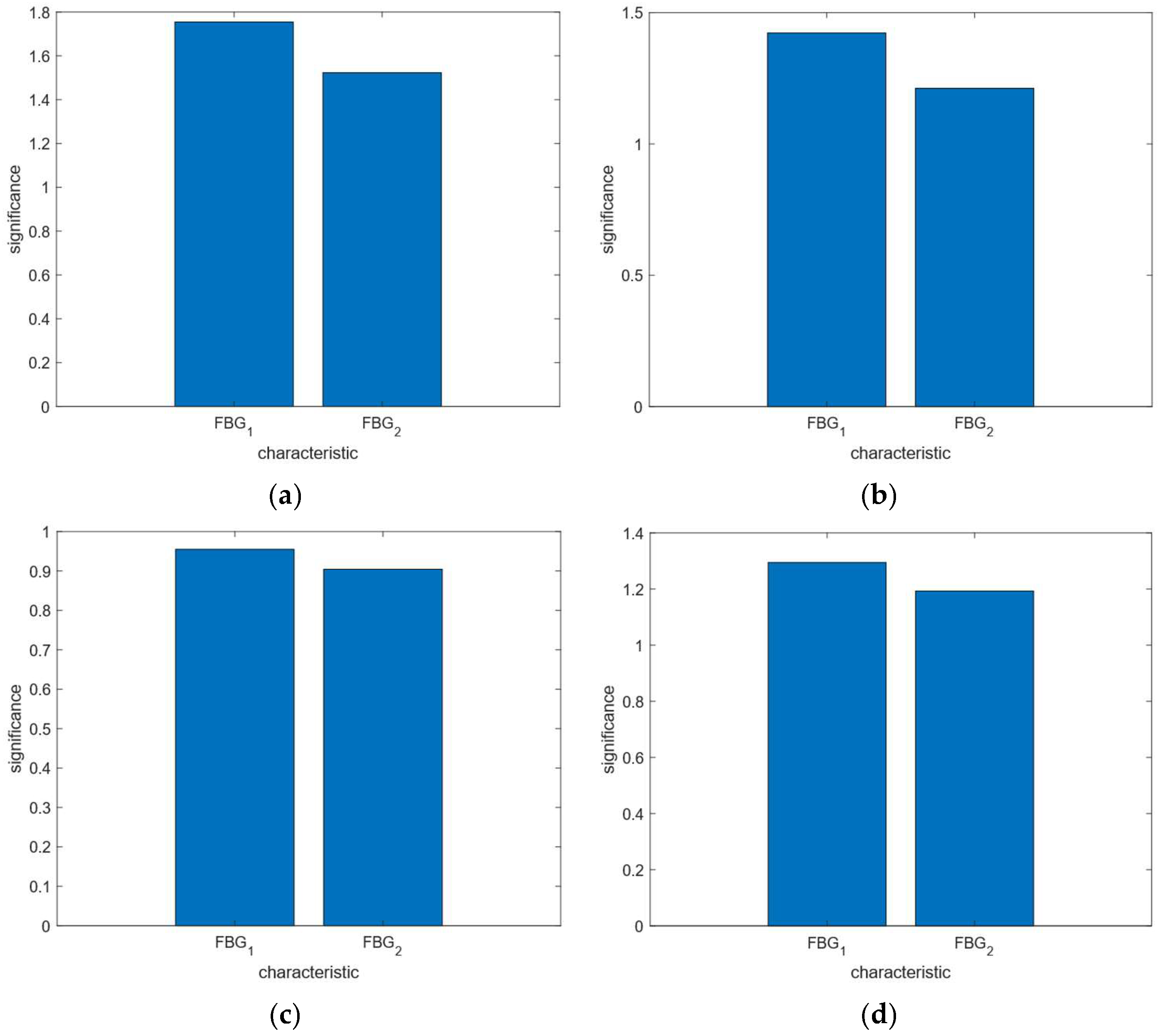1. Introduction
In recent years, the importance of monitoring vital signs in daily life has been growing significantly. Among these, breathing parameters serve as critical indicators in the assessment of human health status. The structure monitoring sensor and human compatibility of the sensing unit plays an important role in determining the overall monitoring performance of the breathing equipment. There are various types of sensors for monitoring human breathing, including both non-optical fiber sensors and optical fiber sensors. Non-optical fiber sensors include electrical signal sensors, graphene sensors, effort belts, nasal thermistors, etc. Optical fiber sensors mainly include Fabry-Perot interferometer-based sensors and FBG sensors.
In 2024, Julia et al. designed OptiBreathe—an earable-based PPG system for continuous respiration rate, breathing phase, and tidal volume monitoring [
1]. Nora Asyikin Binti et al. have designed a 3D-printed magnetic-based air pressure sensor for continuous respiration monitoring and breathing rehabilitation [
2]. Rajendran et al. have designed carbon dots-decorated graphitic carbon nitride as a practical and flexible metal-free nanosensor for breath humidity monitoring [
3]. Sharma et al. have designed a crosstalk-free graphene–liquid elastomer based printed sensors for unobtrusive respiratory monitoring [
4]. In 2024, Zhang et al. designed a highly humidity-sensitive Fabry-Perot interferometer sensor based on a liquid−solid microcavity for breath monitoring [
5]. Shi et al. have designed a flexible wearable fiber-optic sensor for real-time human breath monitoring based on a Fabry-Perot interferometer with an agar film [
6]. Kobayakawa et al. have designed a simultaneous measurement of respiratory behavior using three different sensors: pressure transducer-based, belt-type, and thermistor-based methods [
7]. The fabrication of the above-mentioned breathing monitoring sensors is complex, and most of the studies evaluated breathing function through exhaled gas humidity measurements. Their functionality is largely determined by the material characteristics, although the structural configuration is comparatively simple.
The optical fiber Bragg grating (FBG) sensor exhibits excellent characteristics such as high linearity, strong anti-interference ability, and ease of implantation, making it suitable for the application of human breathing monitoring [
8,
9,
10].
The FBG sensor can be combined with algorithm models [
11], mechanical structures [
12,
13], biomaterials [
14,
15], and signal processing [
16] to monitor human breathing. These measures optimize the performance of the FBG in breathing monitoring, increase sensitivity, eliminate temperature interference and improve the biocompatibility of the FBG sensor with the human body. In 2023, Liu et al. from Changchun University of Science and Technology fixed an FBG on the chest with an elastic band for the monitoring of breathing and heartbeat frequency [
17]. Wang et al.’s research team from Guangdong Province designed a double-layer structure using PDMS (Polydimethylsiloxane), placing an FBG in the middle of the second layer [
18]. In 2024, Beijing Normal University developed a wearable micro-fiber intelligent sensor, which uses polymer micro-fiber to monitor human breathing conditions with high efficiency [
19]. Based on the reviewed literature, FBG sensors are gaining prominence in breathing monitoring due to their high sensitivity and compact design. Although prior studies have employed FBG sensors, their implementations often necessitate advanced materials with superior mechanical properties and complex signal processing algorithms to achieve reliable data interpretation. Notably, existing research has yet to explore gender-specific variations in breathing patterns—a key innovation addressed in our work.
This work developed an adjustable FBG sensing unit to monitor the breathing rate and temperature, including a bare FBG and a FBG encapsulated within a silicone tube. The schematic diagram of the adjustable FBG sensing unit is described in
Section 2. The FBG sensing unit features adjustable connecting holes on the ear hangers, allowing it to suit different facial sizes.
Section 3 explains the working principle of nasal breathing monitoring. A normal breathing process exerts pressure on the FBG sensing unit, which undergoes deformation and applies strain to FBGs in proportion to the breathing frequency. In
Section 4, the calibration experiments and the nasal breathing experiments under the resting state and the motion state are displayed in detail. In addition, we employed a random forest algorithm to analyze the breathing data. FBG
1 demonstrates superior monitoring performance compared to FBG
2, clearly indicating that pressure positively influences nasal breathing monitoring.
2. Adjustable FBG Sensing Unit for Monitoring Nasal Breathing
During human breathing, temperature and force variations occur in the nasal cavity. Exhalation exerts an outward thrust, expelling high-temperature air from the body, while inhalation does not produce external force or high temperatures.
To precisely monitor respiratory activity, FBG1 is encapsulated in a silicone tube. Since the silicone tube is prone to deformation when subjected to force, the force sensitivity of FBG1 is greater than that of FBG2.
The thermal expansion coefficient of the silicone tube is approximately 200 × 10
−6/°C, while that of the bare fiber FBG is about 0.55 × 10
−6/°C. Under the same temperature, the expansion of the silicone tube is greater than that of the bare FBG. The expansion of the silicone tube causes FBG
1 to stretch, increasing its wavelength. As a result, the temperature sensitivity of FBG
1 is higher than that of FBG
2. The details are shown in
Figure 1.
The mechanical structure of the monitoring sensing unit was accomplished with 3D printing techniques using a material called PLA (Polylactic acid). Its density typically ranges from 1.24 to 1.30 g/cm3, and PLA has a low thermal conductivity. The vent can dissipate the heat during breathing, reducing the temperature effects of FBGs. Part A is the front panel of the FBG sensing unit, used for monitoring breathing status. Part B is the connecting link used to connect part A and part B, and to adjust the distance between the monitoring sensing unit and the nostril. Part C is the hanging leg. It is connected to the ear, like the frame of glasses, and adjusts the distance between the monitoring sensing unit and the nostril. There are connecting holes in part B and part C, allowing people with different face sizes to wear it.
Since the maximum force applied during the force calibration of the sensor in part A was 0.5 N, a 0.5 N load was consequently used for the mechanical simulation of part A. To verify whether the structures of part B and part C could support their own weight, a tensile testing machine (ZMF-50) was used to measure their weight, confirming that it did not exceed 1 N. ANSYS (2022 R1) was then employed to conduct mechanical simulations on part B and part C by applying a 1 N force, determining whether significant deformation occurred, as shown in
Figure 2.
The simulation results indicate that part A exhibited no significant deformation under a 0.5 N load, demonstrating the structural integrity of the design. The simulation results demonstrate that neither part B nor part C exhibited significant deformation under a 1 N load, confirming the fundamental structural reliability.
FBG
1 is capsulated by a silicone tube, and FBG
2 is bare. The inner diameter of the silicone tube is 0.5 mm. The diameters of the fixed hole and the pilot hole are 3 mm. FBG
1 uses K-705 silicone to protect its grid area and silicone tubing to encapsulate and protect it, after which it is structurally fixed to the monitoring sensing unit using 502 glue and UV glue, respectively. FBG
2 uses K-705 silicone to protect its grid area, after which it is structurally fixed to the monitoring sensing unit using 502 glue and UV glue, respectively. The details are shown in
Figure 3.
3. Working Principle
3.1. FBG Sensing Principle
The FBG’s Bragg resonant wavelength
is the wavelength at which the incident light is reflected by the FBG, expressed as Equation (1) [
20,
21]. The details are shown in
Figure 4.
where
neff is the effective index of the fiber core and
is the grating pitch.
FBG’s Bragg resonant wavelength shifts when it is under strain and temperature with
expressed as Equation (2)
where
is the strain sensitivity,
is the temperature sensitivity,
is the change of axial strain, and
is the temperature change.
is the effective elastic-optic coefficient,
is the coefficient of thermal expansion, and
is the thermal-optical coefficient.
3.2. Monitoring Principles
The FBG sensor can sense the strain and temperature simultaneously. Nasal breathing parameters can be reflected via pressure and temperature changes [
22,
23].
According to Equation (2), the relationships between the wavelengths of FBG
1 and FBG
2 and parameters such as strain and temperature can be obtained. Equations (3) and (4) can express these relationships:
Two FBG sensors are used to monitor the breathing rate. The normal breathing process includes exhalation and inhalation, which apply pressure and temperature to the FBG sensing unit. The FBG sensing unit undergoes deformation, thereby causing changes in the wavelengths of FBG
1 and FBG
2. The rhythm of the wavelength changes is proportional to the breathing rate. During the breathing process, the wavelength variation rhythms of FBG
1 and FBG
2 are consistent, as shown in Equation (5):
where
is the time interval during which the strain of FBG increases or decreases by a certain amount during breathing;
is the breathing coefficient and refers to the frequency coefficient of the volunteers’ breathing, which may vary depending on different individuals and breathing conditions (a higher value suggests an elevated breathing rate within the given time interval, while a lower value corresponds to a reduced breathing rate.);
f is the breathing rate, which may vary depending on different individuals and breathing conditions (elevated values correspond to increased breathing rates during the measurement period, while diminished values reflect decreased breathing frequency).
4. Experiment of Nasal Breathing
It is well known that there is temperature and breathing pressure during nasal breathing. We carried out the temperature calibration and the pressure calibration experiment before the nasal breathing experiment. Four groups of the nasal breathing experiment are listed in
Table 1.
4.1. Calibration Experiment
Figure 5 shows the calibration experimental setup. Thermostat (GA150-4) (Bin Gu Technology (Shanghai) Co., Ltd., Shanghai, China) was used to control the temperature from 20 °C to 44 °C every 3 °C. The electronic universal testing machine (C65.102) (New Thought (Shanghai) Enterprise Development Co., Ltd., Shanghai, China) was employed to exert loads from 0 N to 0.5 N in increments of 0.1 N. The FBG interrogator (HB-FBG-1000-8) (Huibang (Hangzhou) Sensor Technology Co., Ltd., Hangzhou, China) acquired the Bragg resonant wavelength responses.
Three calibration experiments were performed for FBG
1 and FBG
2 separately, to measure temperature and force during forward and reverse strokes. The repeatability of the sensing unit was evaluated by calculating the error between forward and reverse strokes based on deviations in average temperature and force sensitivity (FBG
1 and FBG
2) from their calibration values. The calibration experimental results and error bars are shown in
Figure 6.
According to the calibration experiment data, FBG
1 has an average temperature sensitivity of 6.77 pm/°C and an average goodness of fit of 0.9980, and it has an average pressure sensitivity of 2.05 pm/N and an average goodness of fit of 0.9948. FBG
2 has an average temperature sensitivity of 6.18 pm/°C and an average goodness of fit of 0.9955, and it has an average pressure sensitivity of 1.18 pm/N and an average goodness of fit of 0.9945. Due to the silicone tube encapsulating and protecting FBG
1, the silicone tube undergoes significant deformation under stress, resulting in FBG
1’s force sensitivity being higher than that of FBG
2. The data in
Figure 6e–h indicate that the temperature sensitivity error (compared to the average sensitivity of FBG
1 and FBG
2) is consistently below 4% for both forward and reverse strokes under the same conditions. In contrast, the force sensitivity exhibits a higher but still acceptable variation, with a maximum error of around 10%. These findings confirm the high repeatability of the sensing unit in monitoring applications.
To enhance the consistency of force calibration for the sensing units under actual breathing conditions, dynamic pressure calibration experiments were performed. FBG
1 and FBG
2 underwent dynamic calibration via an electronic universal testing machine, with cyclic loading ranges of [0 N, 0.5 N] and [0 N, 0.3 N] applied to simulate physiological loading conditions. For each sensor, two separate experimental trials were carried out, with each trial comprising three complete calibration cycles. The dynamic calibration experimental results are shown in
Figure 7.
The theoretical wavelength for each cycle peak in the dynamic calibration was determined by multiplying the pressure sensitivity coefficients (obtained from static calibration of FBG
1 and FBG
2) by their respective maximum applied forces (the peak forces were 0.5 N and 0.3 N, respectively). The error was then calculated by comparing these theoretical values with the actual peak wavelengths measured during the dynamic calibration experiments. A comparative analysis of the experimental data is presented in
Table 2.
Experimental results demonstrate excellent agreement between dynamic and static calibration, with a maximum wavelength deviation of only 0.18 pm between the dynamic calibration peaks and their theoretical counterparts. This close correlation confirms that the monitoring sensing unit maintains consistent performance under both dynamic and static calibration conditions.
4.2. Experiments of Group I and Group II
In the group I experiment, the male volunteer breathed for 60 s. In the group II experiment, he breathed for 60 s after an intense motion (going up and down stairs for 20 min). The FBG interrogator acquired the FBGs’ responses. The experimental data are shown in
Figure 8. In addition,
Figure 9 illustrates the wavelength shifts during his breathing cycle.
As shown in
Figure 8, within 60 s, the breathing rate of the resting male was 13.48 times/min, and that of motion male was 23.91 times/min. The breathing rate of group II was bigger than that of group I. According to
Figure 9, the wavelength of expiratory increased while the wavelength of inspiratory decreased. The difference in breathing wavelength in group II was 0.013 nm, and the difference in breathing wavelength in group I was 0. 010 nm. The temperature of group II exhaled was higher than that of group I. As shown in
Figure 9, the FBG responses of group I were gentler than that of group II. The breathing rate of group I was lower than that of group II.
4.3. Experiments of Group III and Group IV
In the group III experiment, the female volunteer breathed for 60 s. In the group IV experiment, she breathed for 60 s after an intense motion (going up and down stairs for 20 min). The FBG interrogator acquired the FBGs’ responses. The experimental data are shown in
Figure 10. In addition,
Figure 11 shows the wavelength shifts during her breathing cycle.
As shown in
Figure 10, within 60 s, the breathing rate of resting female was 14.12 times/min, and that of motion female was 24.59 times/min. The breathing rate of group IV was bigger than that of group III. According to
Figure 11, the wavelength of expiratory increased, while the wavelength of inspiratory decreased. The difference in breathing wavelength in group IV was 0.011 nm, and the difference in breathing wavelength in group III was 0. 005 nm. The temperature of group IV exhaled was higher than that of group III. As shown in
Figure 11, the FBG responses of group IV were gentler than that of group III. The FBG sensing unit could monitor the breathing of the different conditions. The breathing rate of group III was lower than that of group IV.
4.4. Verification of the Insignificance of Different Sensors and States
To verify whether the difference between the resting state and the exercise state in the experiment is significant, breathing data from group I, group II, group III, and group IV under different states were analyzed using variance validation. A comparison was conducted using the data monitored from group I, group II, group III, and group IV (FBG
1 and FBG
2), as shown in
Figure 12.
Through variance analysis, it was found that the variances of FBG1 and FBG2 in monitoring the data of group I, group II, group III and group IV under different conditions were both below 0.05, indicating that the differences between FBG1 and FBG2 or between resting and exercise conditions are significant.
4.5. Multi-State Verification Experiment
To verify whether the monitoring sensor unit can accurately detect breathing status under different conditions, we designed two experimental scenarios: simulated apnea testing and standing-position monitoring. Preliminary validation was completed using group I, group II, group III, and group IV. To expand the test population, this section’s verification experiments were conducted with two additional subjects: volunteer 3 (a 20-year-old female) and volunteer 4 (a 25-year-old male). The specific experimental setup is shown in
Figure 13.
As can be seen in
Figure 13, the monitoring sensing unit can correctly differentiate between apnea and breathing conditions, and the condition of breathing while standing can be monitored. This proves that the monitoring sensor unit can monitor more people and has the capability to detect various breathing conditions.
4.6. Contrastive Analysis
To verify whether the breathing frequency obtained from the monitoring sensing unit has similarity with the frequency obtained from the same type of sensor and from different types of sensors, breathing monitoring studies from recent years were cited for comparison. The comparative analysis is shown in
Table 3.
In normal circumstances (resting), a healthy adult breathes at a rate of 12 to 20 breaths per minute, which agrees with our results [
27]. Most current experiments for monitoring breathing do not distinguish between men and women, which is an innovative point for us. The resting and exercising conditions in the above experiments are not identical, and therefore, the breathing rates obtained from monitoring different literature species may vary. The data obtained from the monitoring sensing unit we designed are almost the same as the data obtained from the literature [
27], and the trend of the data obtained from other literature is the same (the breathing rate of the exercising state is greater than that of the resting state).
5. Experimental Results Analysis
Random forest regression, as a machine learning method, is widely used in medical applications due to its high analyzing accuracy, robustness, and adaptability. The analysis in random forest regression is achieved by constructing multiple decision trees, with each tree trained on a different subset of the training data and the feature set. The final analysis for the target variable is obtained by averaging the analyzes from all the trees, where each tree’s output serves as a “vote” and, in the case of regression, the final analysis is the meaning (or weighted mean) of these outputs.
Based on the above analysis and experimental verification, it can be concluded that the wavelength shift of FBG1 during breathing primarily depends on force variations, compared to FBG2. In this study, to validate the reliability of the data obtained from the sensor unit and to assess the impact of force on breathing monitoring, we designed a random forest model based on the breathing state to determine which sensor provides the most significant monitoring results.
Random forest was used to analyze the features’ importance. The expiatory phase was defined as 1, and the inspiratory phase was defined as 0.
(mean absolute error),
(mean deviation error), and
(root mean square error) were calculated in random forest to examine the effect of analyzing features importance:
where
n is the number of samples,
is the true value, and
is the analyzed value.
In the random forest model used in this paper, the number of decision trees is 250, the minimum leaf size is 30, the depth of the tree is 10, and the method employed is regression. The training set function in the random forest model is TreeBagger, and the prediction set function is predict. The data used for the randomized forest analysis came from the group I, group II, group III, and group IV breathing monitoring experiments. The data of group I are 450, the data of group II are 570, the data of group III are 510, and the data of group IV are 535. For each data set, the training set accounts for 60%, and the test set accounts for 40%. The model parameters were optimized using a five-fold cross-validation method (where evaluation metrics—
MAE,
MBE, and
RMSE—were calculated for each fold and the average of these metrics across all folds was taken as the final overall evaluation metric). The results analyzed are shown in
Figure 14.
Table 4 shows the results of
MAE,
MBE, and
RMSE. The maximum difference in
MAE between Train-set and Test-set is 0.02. The maximum difference in
MBE between Train-set and Test-set is 0.003. The maximum difference in
RMSE between Train-set and Test-set is 0.03.
When solving this problem, the random forest model can effectively evaluate feature importance, thereby aiding in feature selection and enhancing the interpretability of the model. By optimizing key hyperparameters, the model’s performance can be further improved. Additionally, it exhibits strong generalization capabilities on unseen data and demonstrates robust resistance to overfitting, making it highly reliable. It can be concluded that the test set of the four groups of data is relatively stable. The monitoring effect of FBG1 in the FBG sensing unit is greater than that of FBG2, indicating that pressure has a positive impact on breathing monitoring.
6. Conclusions
We developed an adjustable FBG sensing unit for monitoring nasal breathing, accommodating individuals with varying facial dimensions. The calibration experiment shows that this FBG sensing unit can monitor the breathing rate and temperature simultaneously. The random forest model analysis indicates the data of nasal breathing detected by the FBG sensing unit are relatively stable. Furthermore, FBG1 exhibits a higher monitoring performance than FBG2, highlighting that pressure has a positive impact on nasal breathing monitoring.
Author Contributions
Conceptualization, X.Y. and Y.F.; methodology, X.Y.; software, X.Y.; validation, X.Y., Y.F. and M.X.; formal analysis, Y.F.; investigation, X.Y.; resources, Y.F.; data curation, M.X.; writing—original draft preparation, X.Y.; writing—review and editing, Y.F.; visualization, M.X.; supervision, H.Z.; project administration, H.Z.; funding acquisition, Y.F. All authors have read and agreed to the published version of the manuscript.
Funding
This research was funded by [the National Natural Science Foundation of China under Grant] grant number [51665039], and [the Shanghai Local Colleges and Universities Capacity Building Plan] grant number [61763030]. And The APC was funded by [Yan Feng, Hua Zhang].
Institutional Review Board Statement
Ethical review and approval were waived for this study due to that Nasal Breathing data collected by the FBG sensing unit are not used to identify any personal information about the volunteers. Before the experiment, the volunteers were informed that the collected breathing data were informed that the collected breathing data were only used to evaluate the monitoring performance of two FBG sensors.
Informed Consent Statement
Informed consent was obtained from all subjects involved in the study.
Data Availability Statement
The experimental data are available from Shanghai Large-scale Component Intelligent Manufacturing Robot Technology Collaborative Innovation Center or by contacting the authors directly.
Acknowledgments
This work was supported by the National Natural Science Foundation of China under Grant (51665039) and the Shanghai Local Colleges and Universities Capacity Building Plan (61763030). Thank the volunteers for participating in the experiment. All individuals included in this section have consented to the acknowledgement.
Conflicts of Interest
The authors declare no conflicts of interest.
References
- Romero, J.; Ferlini, A.; Spathis, D.; Dang, T.; Farrahi, K.; Kawsar, F.; Montanari, A. OptiBreathe: An earable-based PPG system for continuous respiration rate, breathing phase, and tidal volume monitoring. In Proceedings of the 25th International Workshop on Mobile Computing Systems and Applications, San Diego, CA, USA, 28–29 February 2024; ACM: New York, NY, USA, 2024; pp. 99–106. [Google Scholar]
- Zulkifli, N.A.; Jeong, W.; Kim, M.; Kim, C.; Ko, Y.H.; Hyun, D.C.; Lee, S. 3D-printed magnetic-based air pressure sensor for continuous respiration monitoring and breathing rehabilitation. Soft Sci. 2024, 4, 1–14. [Google Scholar] [CrossRef]
- Rajendran, S.; Bhunia, S.K. Carbon dots decorated graphitic carbon nitride as a practical and flexible metal-free nanosensor for breath humidity monitoring. Carbon Lett. 2024, 34, 783–795. [Google Scholar] [CrossRef]
- Sharma, S.; Thapa, A.; Singh, S.; Mondal, T. Crosstalk-free graphene–liquid elastomer based printed sensors for unobtrusive respiratory monitoring. Nanoscale 2024, 16, 3498–3509. [Google Scholar] [CrossRef]
- Zhang, Y.; Liu, P.; Yu, J.; Ye, L.; Tang, X.; Zhang, Y.; Liu, Z.; Yuan, L. Highly humidity sensitive Fabry-Perot interferometer sensor based on a liquid-solid microcavity for breath monitoring. Opt. Fiber Technol. 2024, 84, 103761. [Google Scholar] [CrossRef]
- Shi, G.; Wang, W.; Guo, Y.; Pan, J.; Sun, D.; Ma, J.; Wu, J. Flexible wearable fiber optic sensor for real-time human breath monitoring based on Fabry-Perot interferometer with agar film. Opt. Express 2024, 32, 33208–33221. [Google Scholar] [CrossRef]
- Kobayakawa, T.; Gotow, N.; Hosono, M.; Ohno, M.; Nishida, Y.; Narumi, T.; Wada, Y. Simultaneous measurement of respiratory behavior using three different sensors: Pressure transducer-based, belt-type, and thermistor-based methods. Sens. Actuators A Phys. 2025, 391, 116632. [Google Scholar] [CrossRef]
- Wang, Z.; Chen, Z.; Ma, L.; Wang, Q.; Wang, H.; Leal-Junior, A.; Li, X.; Marques, C.; Min, R. Optical microfiber intelligent sensor: Wearable cardiorespiratory and behavior monitoring with a flexible wave-shaped polymer optical microfiber. ACS Appl. Mater. Interfaces 2024, 16, 8333–8345. [Google Scholar] [CrossRef]
- Ngiejungbwen, L.A.; Hamdaoui, H.; Chen, M.Y. Polymer optical fiber and fiber Bragg grating sensors for biomedical engineering Applications: A comprehensive review. Opt. Laser Technol. 2024, 170, 110187. [Google Scholar] [CrossRef]
- Prata, D.; Carvalho, A.; Costa, F.M.; Marques, C.; Leitão, C. Unobtrusive monitoring of the respiratory rate in an office desk chair with FBG sensors. In Proceedings of the 2021 IEEE International Workshop on Metrology for Industry 4.0 & IoT (MetroInd4.0&IoT), Rome, Italy, 7–9 June 2021; IEEE: Piscataway, NJ, USA, 2021; pp. 177–181. [Google Scholar]
- Filosa, M.; Massari, L.; Ferraro, D.; D’ALesio, G.; D’ABbraccio, J.; Aliperta, A.; Presti, D.L.; Di Tocco, J.; Zaltieri, M.; Massaroni, C.; et al. A meta-learning algorithm for respiratory flow prediction from FBG-based wearables in unrestrained conditions. Artif. Intell. Med. 2022, 130, 102328. [Google Scholar] [CrossRef]
- Shi, C.; Tang, Z.; Zhang, H.; Liu, Y. Development of an FBG-based wearable sensor for simultaneous respiration and heartbeat measurement. IEEE Trans. Instrum. Meas. 2022, 72, 4000409. [Google Scholar]
- Zaltieri, M.; Presti, D.L.; Bravi, M.; Caponero, M.A.; Sterzi, S.; Schena, E.; Massaroni, C. Assessment of a multi-sensor FBG-based wearable system in sitting postures recognition and respiratory rate evaluation of office workers. IEEE Trans. Biomed. Eng. 2022, 70, 1673–1682. [Google Scholar] [CrossRef] [PubMed]
- De Tommasi, F.; Massaroni, C.; Caponero, M.A.; Carassiti, M.; Schena, E.; Presti, D.L. FBG-based mattress for heart rate monitoring in different breathing conditions. IEEE Sens. J. 2023, 23, 14114–14122. [Google Scholar] [CrossRef]
- Presti, D.L.; Massaroni, C.; Bianchi, D.; Caponero, M.; Gizzi, A.; Schena, E. Development of a flexible sensor based on fiber Bragg grating technology for simultaneous respiratory and heartbeat measurements. In Proceedings of the 2023 IEEE International Symposium on Medical Measurements and Applications (MeMeA), Jeju, Republic of Korea, 14–16 June 2023; IEEE: Piscataway, NJ, USA, 2023; pp. 1–6. [Google Scholar]
- Guo, Y.; Tong, X.; Shen, Y.; Wu, H. Wearable Optical Fiber Beat Frequency Digital Sensing System for Real-Time Non-Invasive Multiple Human Physiological Parameters Monitoring. J. Light. Technol. 2023, 41, 2911–2920. [Google Scholar] [CrossRef]
- Taoping, S.; Zhichao, L. Design of pulse and respiration monitoring system based on fiber optic sensing and VMD-FPR processing algorithm. Opt. Fiber Technol. 2022, 73, 103033. [Google Scholar] [CrossRef]
- Wang, H.; Zheng, J.; Nie, Q.; Zhao, C.; Wang, Z.; Kumar, S.; Marques, C.; Min, R.; Hu, X. Sleep Sense: Smart pillow with pressure-sensitive FBG-embedded silicone buttons. IEEE Sens. J. 2023, 23, 19324–19331. [Google Scholar] [CrossRef]
- Zhao, C.; Liu, D.; Xu, G.; Zhou, J.; Zhang, X.; Liao, C.; Wang, Y. Recent advances in fiber optic sensors for respiratory monitoring. Opt. Fiber Technol. 2022, 72, 103000. [Google Scholar] [CrossRef]
- Kumar, S.; Kumar, N.; Singh, J. Design and analysis of oil pipeline leakage detection model using WDM FBG sensors through simulation of temperature and strain effects. In Proceedings of the 2022 OPJU International Technology Conference on Emerging Technologies for Sustainable Development (OTCON), Raigarh, India, 8–10 February 2023; IEEE: Piscataway, NJ, USA, 2023; pp. 1–6. [Google Scholar]
- Yang, S.; Wang, H.; Meng, L.; Chen, Y.; Dong, B.; Yuan, T.; Zhang, X.; Yuan, L. Dual-FBG and FP cavity compound optical fiber sensor for simultaneous measurement of bending, temperature and strain. J. Light. Technol. 2022, 41, 1582–1588. [Google Scholar] [CrossRef]
- Li, J.; Pan, J.; Xu, C.; Wu, Z.; Zhang, J.; Li, X.; Huang, T. Temperature and strain monitoring system based on linear optical sampling. In Proceedings of the 2023 21st International Conference on Optical Communications and Networks (ICOCN), Qufu, China, 31 July–3 August 2023; IEEE: Piscataway, NJ, USA, 2023; pp. 1–3. [Google Scholar]
- Luo, Z.; Zhou, X.; Yang, L. Temperature compensation study of FBG sensors for strain monitoring in large science devices. In Proceedings of the 2023 IEEE 5th International Conference on Civil Aviation Safety and Information Technology (ICCASIT), Dali, China, 11–13 October 2023; IEEE: Piscataway, NJ, USA, 2023; pp. 343–347. [Google Scholar]
- Lin, J.; Chen, H.; Ling, Q.; Shen, Q.; Luo, S.; Akhtar, A.; Zhu, C.; Yu, Z.; Liu, L.; Guan, Z.; et al. Respiratory rate monitoring based on all-fiber strain-induced humidity sensor. Opt. Laser Technol. 2025, 181, 111840. [Google Scholar] [CrossRef]
- Yang, Q.; Yu, M.; Zhang, H.; Li, N.; Du, J.; Xu, L.; Xu, J. Triboelectric nanogenerator based on well-dispersed and oxide-free liquid metal-doped conductive hydrogel as self-powered wearable sensor for respiratory and thyroid cartilage signal monitoring. Nano Energy 2025, 134, 110530. [Google Scholar] [CrossRef]
- Chen, X.; Peng, X.; Wei, C.; Wang, Z.; He, J.; Sheng, H.; Jiang, T.; Dong, K. A Moisture-Proof, Anti-Fouling, and Low Signal Attenuation All-Nanofiber Triboelectric Sensor for Self-Powered Respiratory Health Monitoring. Adv. Funct. Mater. 2025, 35, 2415421. [Google Scholar] [CrossRef]
- Mandal, S.; Mantilla, H.M.; Loganathan, K.; Faber, H.; Sharma, A.; Gedda, M.; Yengel, E.; Goswami, D.K.; Heeney, M.; Anthopoulos, T.D. Ultra-Fast Moisture Sensor for Respiratory Cycle Monitoring and Non-Contact Sensing Applications. Adv. Mater. 2025, 37, 2414005. [Google Scholar] [CrossRef] [PubMed]
- Wang, H.; Zheng, J.; Nie, Q.; Li, W.; Wang, Z.; Xiao, K.; Hu, X.; Kumar, S.; Min, R. Double-Fishtail-Shaped FBG wearable device for sitting posture recognition and real-time respiratory monitoring. IEEE Sens. J. 2024, 24, 10164–10171. [Google Scholar] [CrossRef]
- Yin, B.; Wang, L.; Liu, J.; Gao, S.; Zhang, Y.; Hong, L.; Chen, F.; Tian, M. Integrated Janus Meta-Fabric via an Interlock Stitch Knitted Structure for Marginal Physiological Signal Monitoring. ACS Appl. Electron. Mater. 2025, 7, 1120–1129. [Google Scholar] [CrossRef]
Figure 1.
Schematic of the FBG sensing unit: (a) assembly drawing; (b) part A; (c) key dimensions for part A; (d) key dimensions for part B; (e) key dimensions for part C.
Figure 1.
Schematic of the FBG sensing unit: (a) assembly drawing; (b) part A; (c) key dimensions for part A; (d) key dimensions for part B; (e) key dimensions for part C.
Figure 2.
Deformation simulation experiments: (a) weighing experiment; (b) simulation of part B; (c) simulation of part C; (d) simulation of part A.
Figure 2.
Deformation simulation experiments: (a) weighing experiment; (b) simulation of part B; (c) simulation of part C; (d) simulation of part A.
Figure 3.
The packaging of the FBG sensor: (a) process flow; (b) packaged type.
Figure 3.
The packaging of the FBG sensor: (a) process flow; (b) packaged type.
Figure 4.
Schematic of the FBG sensor: (a) schematic diagram; (b) SEM images of the axial view; (c) SEM images of the cross-sectional view.
Figure 4.
Schematic of the FBG sensor: (a) schematic diagram; (b) SEM images of the axial view; (c) SEM images of the cross-sectional view.
Figure 5.
Calibration experimental setup: (a) temperature calibration; (b) pressure calibration.
Figure 5.
Calibration experimental setup: (a) temperature calibration; (b) pressure calibration.
Figure 6.
Calibration experiment data: (a) FBG1’s temperature data; (b) FBG2’s temperature data; (c) FBG1’s pressure data; (d) FBG2’s pressure data; (e) FBG1’s temperature repeatability error data; (f) FBG2’s temperature repeatability error data; (g) FBG1’s pressure repeatability error data; (h) FBG2’s pressure repeatability error data.
Figure 6.
Calibration experiment data: (a) FBG1’s temperature data; (b) FBG2’s temperature data; (c) FBG1’s pressure data; (d) FBG2’s pressure data; (e) FBG1’s temperature repeatability error data; (f) FBG2’s temperature repeatability error data; (g) FBG1’s pressure repeatability error data; (h) FBG2’s pressure repeatability error data.
Figure 7.
Dynamic calibration experiment data at different force ranges: (a) force range of [0 N,0.5 N]; (b) force range of [0 N,0.3 N].
Figure 7.
Dynamic calibration experiment data at different force ranges: (a) force range of [0 N,0.5 N]; (b) force range of [0 N,0.3 N].
Figure 8.
Group I and group II experiments: (a) photo of a male’s nasal breathing; (b) resting state wave of FBG1; (c) resting state wave of FBG2; (d) motion state wave of FBG1; (e) motion state wave of FBG2.
Figure 8.
Group I and group II experiments: (a) photo of a male’s nasal breathing; (b) resting state wave of FBG1; (c) resting state wave of FBG2; (d) motion state wave of FBG1; (e) motion state wave of FBG2.
Figure 9.
FBG1 monitors wavelength changes with one cycle of breathing: (a) group I; (b) group II.
Figure 9.
FBG1 monitors wavelength changes with one cycle of breathing: (a) group I; (b) group II.
Figure 10.
Group III and group IV experiments: (a) photo of a female’s nasal breathing; (b) resting state wave of FBG1; (c) resting state wave of FBG2; (d) motion state wave of FBG1; (e) motion state wave of FBG2.
Figure 10.
Group III and group IV experiments: (a) photo of a female’s nasal breathing; (b) resting state wave of FBG1; (c) resting state wave of FBG2; (d) motion state wave of FBG1; (e) motion state wave of FBG2.
Figure 11.
FBG1 monitors wavelength changes with one cycle of breathing: (a) group III; (b) group IV.
Figure 11.
FBG1 monitors wavelength changes with one cycle of breathing: (a) group III; (b) group IV.
Figure 12.
Analysis of the differences between the resting state and the active state: (a) group I and group II; (b) group III and group IV.
Figure 12.
Analysis of the differences between the resting state and the active state: (a) group I and group II; (b) group III and group IV.
Figure 13.
Multi-pose verification experiment: (a) monitoring experiment diagram; (b) apnea testing stimulated by volunteer 3; (c) apnea testing by volunteer 3; (d) standing-position monitoring of volunteer 4; (e) standing-position monitoring of volunteer 4.
Figure 13.
Multi-pose verification experiment: (a) monitoring experiment diagram; (b) apnea testing stimulated by volunteer 3; (c) apnea testing by volunteer 3; (d) standing-position monitoring of volunteer 4; (e) standing-position monitoring of volunteer 4.
Figure 14.
Significance of features in random forest analysis: (a) group I; (b) group II; (c) group III; (d) group IV.
Figure 14.
Significance of features in random forest analysis: (a) group I; (b) group II; (c) group III; (d) group IV.
Table 1.
Four groups of the nasal breathing experiment.
Table 1.
Four groups of the nasal breathing experiment.
| Group I | Group II | Group III | Group IV |
|---|
| Male’s resting | Male’s motion | Female’s resting | Female’s motion |
Table 2.
Comparison of dynamic calibration peak wavelength and theoretical peak wavelength data.
Table 2.
Comparison of dynamic calibration peak wavelength and theoretical peak wavelength data.
| | Peak Force | Theoretical Wavelength | Actual Wavelengths/Errors at Different Points |
|---|
| 1 | Errors | 2 | Errors | 3 | Errors |
|---|
| FBG1 | 0.5 N | 1557.30312 nm | 1557.3031 nm | 0.02 pm | 1557.3032 nm | 0.08 pm | 1557.3033 nm | 0.18 pm |
| 0.3 N | 1557.30271 nm | 1557.3028 nm | 0.09 pm | 1557.3027 nm | 0.01 pm | 1557.3027 nm | 0.01 pm |
| FBG2 | 0.5 N | 1554.0019 nm | 1554.002 nm | 0.1 pm | 1554.0021 nm | 0.1 pm | 1554.002 nm | 0.1 pm |
| 0.3 N | 1554.00176 nm | 1554.0017 nm | 0.06 pm | 1554.0016 nm | 0.16 pm | 1554.0018 nm | 0.04 pm |
Table 3.
Comparison of the breathing rates obtained from the monitoring of the proposed sensor with other sensors reported in the literature.
Table 3.
Comparison of the breathing rates obtained from the monitoring of the proposed sensor with other sensors reported in the literature.
| Type | State | Frequency (r/min) | Ref |
|---|
| FBG sensing unit | Male’s resting | 13.48 | |
| Male’s motion | 23.91 |
| Female’s resting | 14.12 |
| Female’s motion | 24.59 |
| All-fiber strain-induced humidity sensor | Resting | 18 | [24] |
| Motion | 52.8 |
| Conductive hydrogel | Resting | 18 | [25] |
| Motion | 57 |
| All-nanofiber triboelectric sensor | Resting | about 24 | [26] |
| Motion | about 36 |
| Ultra-fast moisture sensor | Resting | about 19.3 | [27] |
| Motion | about 36.4 |
| Double-fishtail-shaped FBG | Resting | 9.6 | [28] |
| Motion | 20.4 |
| Interlock-stitched knitted structure | Resting | about 24 | [29] |
| Motion | about 60 |
Table 4.
Predicting results.
Table 4.
Predicting results.
| | Group I | Group II | Group III | Group IV |
|---|
| Train-set MAE | 0.20 | 0.16 | 0.21 | 0.27 |
| Test-set MAE | 0.21 | 0.15 | 0.19 | 0.28 |
| Train-set MBE | 0.007 | 0.008 | 0.004 | 0.005 |
| Test-set MBE | 0.004 | 0.009 | 0.007 | 0.003 |
| Train-set RMSE | 0.29 | 0.18 | 0.22 | 0.35 |
| Test-set RMSE | 0.27 | 0.17 | 0.19 | 0.36 |
| Disclaimer/Publisher’s Note: The statements, opinions and data contained in all publications are solely those of the individual author(s) and contributor(s) and not of MDPI and/or the editor(s). MDPI and/or the editor(s) disclaim responsibility for any injury to people or property resulting from any ideas, methods, instructions or products referred to in the content. |
© 2025 by the authors. Licensee MDPI, Basel, Switzerland. This article is an open access article distributed under the terms and conditions of the Creative Commons Attribution (CC BY) license (https://creativecommons.org/licenses/by/4.0/).


